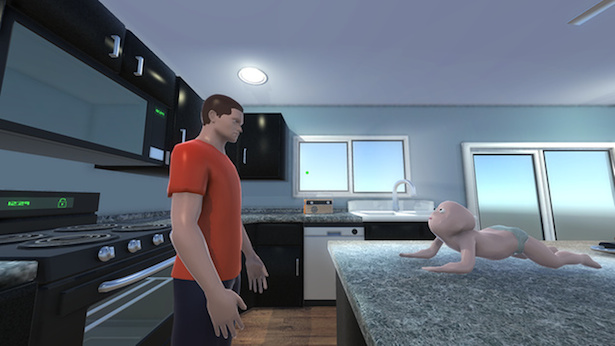Some spoilers here for the second episode of the third season of Black Mirror, “Playtest.”
The shift of Black Mirror to Netflix, with the release of the third season of the dire science-fiction show just in time for Halloween is making some waves. Black Mirror has got to be one of the least binge-worthy shows in Netflix history; sometimes it’s just too heavy for marathon viewing, and the expanded new season is on par with what has come before. Even the episodes that don’t seem too heavy at first, like “Playtest,” turn out to be quite a weight on the psyche. “Playtest” begins with a young man named Cooper heading on a whirlwind trip around the world in an effort to escape grief and guilt after the death of his father. On the last leg of his trip, he runs into a little financial difficulty, but with the help of a tech journalist, he hits on an opportunity to serve as a playtester for a super secret experience from a renowned creator of horror games.
Surprise! Things go badly. The game Cooper’s playtesting is some sort of AR experience, but what it actually is, we can never quite be sure, because the episode plays tricks with the viewer. Maybe it’s what we see, and maybe it’s not. By the end, little is certain, except that Cooper has had a real bad time, and AR games suddenly seem less of a fun move forward and more of a complete nightmare pregnant with terrible possibility.
Here’s the spoiler, if you haven’t seen the episode and want to skip a few paragraphs: Cooper has already agreed to secrecy but manages to slip a photo out to the writer he met, which she told him would mean big money. The company rep had taken his phone and turned it off. He turns it back on while she’s gone to get the missing (was it really missing?) signature page of Cooper’s NDA, and it never gets turned back off. Turns out that’s a major problem for the software, and for Cooper.
 “Playtest” is full of messages, as with any episode of Black Mirror, and while the danger of pushing technology too far, too fast is perhaps foremost among them here, certainly there’s also a warning against cheating. Cooper hadn’t yet signed the NDA when he turned his phone back on, but he was still violating the spirit of a compact, a verbal agreement. He knew the situation. What he couldn’t have guessed were the stakes. But that’s always the problem when we’re chasing new frontiers of technology, isn’t it? We can see some of the potential, the benefits. But we don’t always know what it will cost. What we’re risking.
“Playtest” is full of messages, as with any episode of Black Mirror, and while the danger of pushing technology too far, too fast is perhaps foremost among them here, certainly there’s also a warning against cheating. Cooper hadn’t yet signed the NDA when he turned his phone back on, but he was still violating the spirit of a compact, a verbal agreement. He knew the situation. What he couldn’t have guessed were the stakes. But that’s always the problem when we’re chasing new frontiers of technology, isn’t it? We can see some of the potential, the benefits. But we don’t always know what it will cost. What we’re risking.
I kept yelling “no” at the screen while watching “Playtest,” no to advanced, personalized survival horror games in general, no to unknown technology being inserted into bodies, no to the flippancy with which Cooper approached the whole thing, but definitely no to any kind of AR horror experience in general. VR horror sounds bad enough to me, but it’s still a separation, something that happens somewhere else. AR is laid over my world. What happens when I can’t unsee an AR experience? When you can’t turn it off? No. Nope.
So of course, I immediately sought one out, despite all my misgivings and shouts of no. Night Terrors is an app that’s long been in development, delayed due to the creators at Novum Analytics’ insistence that it be just right, but perhaps due to funding as well. Night Terrors, in its final version, is a horror experience that takes over your phone, reading location data, analyzing, and delivering structured experiences.
The game controls what you see, what you hear, and where you go. Your device’s LED is all the light you get. The camera and microphone feeds are analyzed and processed in real time. Photorealistic elements are added to the camera feed. Audio is spatialized, mixed with the microphone feed, and then routed to the headphones delivering an immersive binaural audio experience. (emphasis in original)
Novum Analytics is sharing videos and reactions (like this one) on their Twitter feed, and the demo Night Terrors: The Beginning is available now. I tried at various times and in different locations in my house and got different results. All those nopes aside, I’ll probably buy the full game (and regret it). This miniature version of Night Terrors is missing some of the final features, so far as I could tell (I got a limited range of responses, but never played more than 8-10 minutes), but what’s there is an intense horror experience — at least, with the headphones on. I tested it first without headphones, just to get a sense of what I’d experience, because I am very susceptible to scares. But my test didn’t compare at all to the full experience, as the audio adds a lot. It reminded me at once of P.T., with a similarly emphatic, but almost clinical voiceover delivering some information at irregular intervals, but there’s something much more immediate and intense once you enter a closed loop of headphones plus phone. I prefer to be with someone when I play a horror game or watch a horror film, but with this, while maybe there’s someone else in the room, you’re still alone, and everything familiar is very suddenly not.
 While the game comes loaded with warnings, and is meant to be played inside, I confess to some worry about AR horror beyond simply uncomfortable experiences. Other AR experiences, and particularly Pokémon Go, have shown us that players aren’t always going to operate within bounds of rules or with good sense. What happens when people go wandering around outside with a game like Night Terrors, or whatever comes after it? Certainly I don’t want to scaremonger, but I don’t think it’s a huge logical leap to assume we might see some risky behavior as AR games become more common… and perhaps a little desensitization, too. If we start to see people roaming around clutching their phones and scream-laughing at “ghosts” in the trees, it’s just another reason to ignore real screams and real pain for people already too inclined to ignore the suffering of others. Here, too, there may be other potential for missteps, when people are roaming the world, intent on something, but locked into audio that creates a strong separation from the real world. I’m not sure I even want to think of all the possibilities, but I hope Novum Analytics and other companies working on AR games, specifically horror games, do more with those warnings about staying inside. I hope too we have learned from Pokémon Go, which had many physical benefits, but which also contributed to some bad situations for a number of players. I don’t say this because I think AR horror games shouldn’t happen. It’s just that the cynic in me wonders if we’re pushing before we know just what the stakes are.
While the game comes loaded with warnings, and is meant to be played inside, I confess to some worry about AR horror beyond simply uncomfortable experiences. Other AR experiences, and particularly Pokémon Go, have shown us that players aren’t always going to operate within bounds of rules or with good sense. What happens when people go wandering around outside with a game like Night Terrors, or whatever comes after it? Certainly I don’t want to scaremonger, but I don’t think it’s a huge logical leap to assume we might see some risky behavior as AR games become more common… and perhaps a little desensitization, too. If we start to see people roaming around clutching their phones and scream-laughing at “ghosts” in the trees, it’s just another reason to ignore real screams and real pain for people already too inclined to ignore the suffering of others. Here, too, there may be other potential for missteps, when people are roaming the world, intent on something, but locked into audio that creates a strong separation from the real world. I’m not sure I even want to think of all the possibilities, but I hope Novum Analytics and other companies working on AR games, specifically horror games, do more with those warnings about staying inside. I hope too we have learned from Pokémon Go, which had many physical benefits, but which also contributed to some bad situations for a number of players. I don’t say this because I think AR horror games shouldn’t happen. It’s just that the cynic in me wonders if we’re pushing before we know just what the stakes are.




